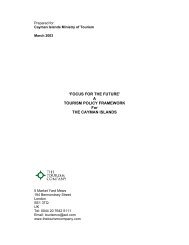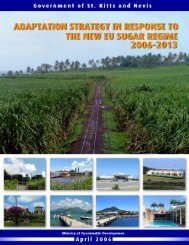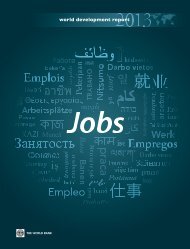Business Removing
Doing Business in 2005 -- Removing Obstacles to Growth
Doing Business in 2005 -- Removing Obstacles to Growth
- No tags were found...
You also want an ePaper? Increase the reach of your titles
YUMPU automatically turns print PDFs into web optimized ePapers that Google loves.
24 DOING BUSINESS IN 2005<br />
burden on all firms, as recently done in Poland, Russia<br />
and Slovakia. This gives every business more incentive<br />
to produce. International evidence suggests that a 1%<br />
reduction in taxes is associated with a 3.7% increase<br />
in firms, a 0.9% increase in sales and a 1.1% increase in<br />
employment. 14<br />
Reforming business start-up can add between a<br />
quarter and half a percentage point to growth rates in<br />
the average developing economy (figure 3.7). These estimates<br />
come from recent firm-level studies that compare<br />
the growth of industries with naturally low entry<br />
barriers, such as retail or food production, to such industries<br />
as chemicals or paper-pulp, with high fixed<br />
entry costs. 15 Growth in naturally “high entry” industries<br />
is especially held back by cumbersome regulations—evidence<br />
that simple regulation spurs growth, not the other<br />
way around.<br />
The result? Adding a quarter percentage point of annual<br />
income growth in developing countries alone<br />
would amount to $14 billion a year, about a quarter of<br />
all international development aid. 16 In Brazil the added<br />
annual growth would cover 25% of spending on primary<br />
education.<br />
There are indirect benefits as well. A study by the<br />
World Bank shows that trade openness contributes<br />
FIGURE 3.7<br />
Lower barriers, higher growth<br />
Additional annual income growth<br />
due to entry reform<br />
Poor country<br />
average<br />
(0.33%)<br />
0.24%<br />
0.25%<br />
0.30%<br />
0.34%<br />
0.37%<br />
0.48%<br />
Mozambique Indonesia Egypt Belarus Bolivia Brazil<br />
Note: The hypothetical reform involves moving from the 75th percentile to the 25th percentile<br />
on the ease of start-up—that is, from a Paraguay to a Sri Lanka.<br />
Source: Calculations based on Klapper, Laeven and Rajan (2004).<br />
about 0.4 percentage points annual economic growth in<br />
countries where labor markets are flexible and business<br />
start-up is easy. 17 Why? Because trade enhances growth<br />
by channeling resources to their most productive uses<br />
in the economy. But if such resource movement is encumbered<br />
by high entry barriers, the effects of trade<br />
diminish and can even be reversed. This explains the<br />
negative effects of trade liberalization in some Latin<br />
American countries, where entry is difficult and labor<br />
markets inflexible.<br />
Notes<br />
1. European Charter for Small Enterprises, available at<br />
http://europa.eu.int/comm/enterprise/enterprise_policy/charter/charter_en.pdf.<br />
2. Thirty-nine countries were monitored between January 2002 and<br />
January 2004 as a part of the IDA13 round of funding. The population-weighted<br />
change during this period was –12% on days to start a<br />
business and –9% on cost to start a business.<br />
3. See Data Notes for details on the methodology.<br />
4. The table shows only paid capital requirements. The minimum capital<br />
requirement in Belgium is 18,550 euro, but of this amount only 20%<br />
needs to be deposited at registration. In Germany only 25% of the<br />
minimum capital or 12,500 euro, whichever is smaller, needs to be<br />
paid at registration. In El Salvador and Uruguay a quarter of the minimum<br />
capital is needed at the start; in Mexico, a fifth.<br />
5. European Commission (2002).<br />
6. Foreign investors now receive the same treatment as domestic ones.<br />
7. The correlation between countries and the Doing <strong>Business</strong> indicator of<br />
recovery rates in insolvency is –.09.<br />
8. Mokyr (2003).<br />
9. Sader (2002).<br />
10. In these countries the commercial registry remains affiliated with the<br />
courts, but the relationship is limited to administrative oversight. In<br />
May 2004 Honduras passed a law to separate the commercial registry<br />
from the courts and make it a public administrative agency.<br />
11. SEBRAE (2000).<br />
12. New registrations grew by 26% in Bosnia and Herzegovina, 16% in<br />
Colombia and 14% in Russia.<br />
13. World Bank (forthcoming).<br />
14. Calculations based on Goolsbee’s (2002) analysis of the effect of corporate<br />
tax on the corporate share of firms, sales and employment. Figures<br />
refer to firms operating in the industry classification “general merchandise.”<br />
Elasticities for other industries are of similar magnitude.<br />
15. Klapper and others (2004) on Eastern and Western European countries,<br />
and Fisman and Sarria-Allende (2004) on rich and middle income<br />
countries. Both studies use the entry regulation measures developed<br />
in Djankov and others (2002) and define good regulation at the<br />
level of the United States—the benchmark is having 4 procedures, 4<br />
days and a cost of 0.5% of the income per capita to start a business.<br />
16. Total income of the 81 IDA countries was $1.1 trillion in 2003, total<br />
aid about $58 billion.<br />
17. Bolaky and Freund (2004).

















